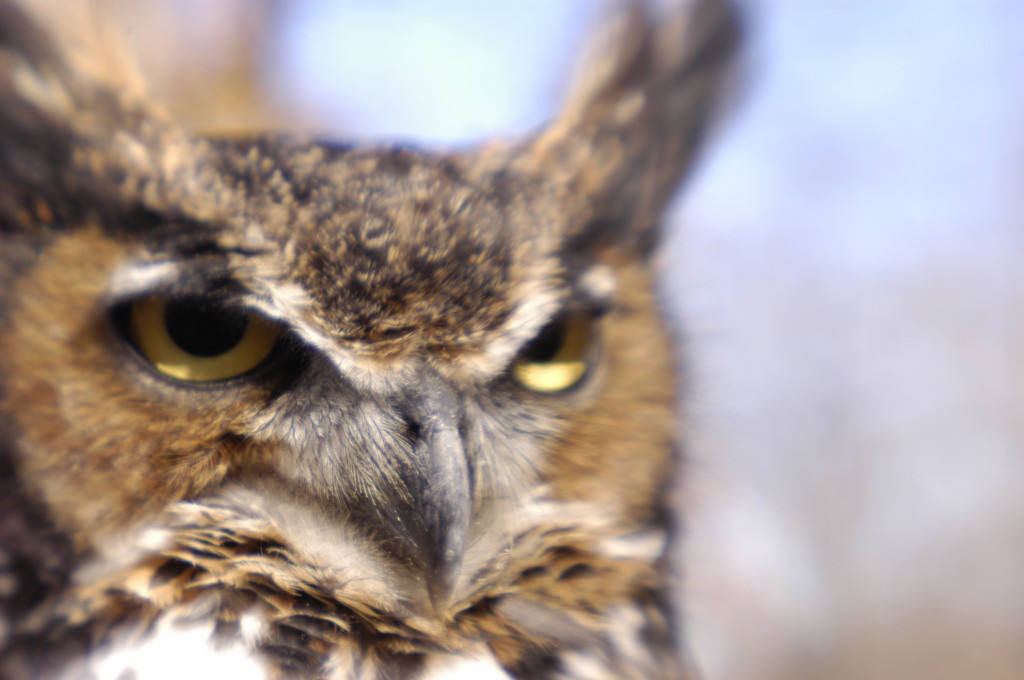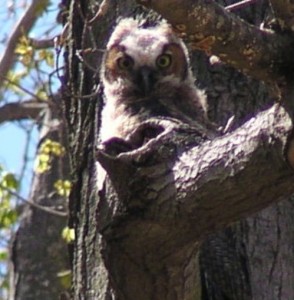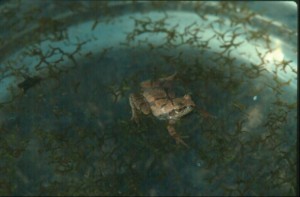Early Spring in Our Bluffs: Grass, Frogs, Owls & More
Spring has already arrived in the wooded bluff lands of Monroe and Randolph Counties. High above Bluff Road, on the limestone ledges of the bluffs’ escarpment, whitlow grass is blooming. A little plant, hairy-stemmed, with tiny, white, four-petaled flowers, whitlow grass really isn’t a grass, but a member of the mustard family. It is a rare plant found only on the bluffs in southwestern Illinois. In order to survive on the harsh and windy bluff face, whitlow grass has developed a clever life-cycle. Its seeds germinate in fall; it grows over the winter and flowers in February; it then produces new seeds and dies back before summer. It’s called whitlow grass because Native Americans and early settlers used it as a medicinal remedy for whitlows — sores under finger or toenails.
Near the end of February, if we get a few warmer days, harbinger-of-spring will begin to bloom. Also called pepper-and-salt, the plant is found throughout the moist, wooded slopes and ravines of the bluffs. A small, delicate plant, with fern-like leaves, it is a member of the parsley family. The white flowers are in clusters at the ends of long stems and have deep dark reddish anthers. Native Americans ate the plant’s bulbs.
Great-horned owls, like whitlow grass, also have a unique reproductive strategy. Because young fledgling owls have a very long, 3-4 month, dependency on their parents to learn hunting skills, adult great-horned owls court and breed in the winter. So courting begins in January, egg incubation is usually in February, and fledgling training begins in March. During this time, our bluffs resound with the mellow “hoo” notes, in rhythmic succession, of great-horned mates starting new families. Great-horned owls are also oftenassociated with red-tailed hawks. Every winter the owls use abandoned red-tailed hawk nests for breeding, and every spring the red-tails use untaken previous nests or simply build new ones. Since both owls and hawks are year-round residents of the bluffs and establish permanent territories here, they live side-by-side, with the great-horned owls ruling the night skies and the red-tailed hawks ruling the daylight.
Spring peepers and wood frogs are the first frogs to breed in our bluffs, usually starting by late February. Both, like many frogs, have a kind of antifreeze in their blood, and can withstand being totally frozen in the soil of their winter burrows. The earliest spring rains and temperatures above 50 F awaken both to breeding. Spring peepers are about 1” long and collect in the grasses andbushes around our numerous sinkhole ponds to breed. Their clear, high-pitched “peeps,” about one per second, are usually the first calls of spring. Wood frogs, more secretive and harder to hear, are 1.5”-2” long, and breed in small woodland ponds, puddles or vernal pools. They live and hide in forest leaf litter. Their breeding calls are a soft, rapid clucking or quacking sound, much like a duck.
Woodcocks will be returning to our bluff lands in late February. Often called timberdoodles by hunters, they are dry-land shorebirds. Wintering in southern states, they are one of the earliest migrant arrivals. Male woodcocks perform remarkable twilight courtship flights called ‘sky dances.’ Beginning about 45 minutes before sunrise and a half hour after sunset, the males will launch spiraling ascents to 200 hundred feet while producing a rising-pitch trill sound with their wing tips. They then dive back in a zigzag, falling-leaf-like descent to the ground, all the time vocalizing “chip-chip-chip.” Males may make ten or twenty of these
60 second flights in a row. It’s really a sight to see and hear.
Thoughts on spring should never overlook our beautiful back yard bird menagerie.
If you live in the bluffs, the forest edge is never far away. And, if you regularly feed birds over the winter, there are a dozen or so loyal species that routinely grace your feeders. Cardinals or redbirds, which everybody recognizes, are always the most prevalent. Next come the noisy and pranksterish blue jays. They are important caretakers of our woods. Famous for hoarding and stashing acorns, nuts and seeds in the woods during winter and then forgetting about it, they contribute greatly to new seedling growth. Three of our five native species of woodpeckers are common at our feeding stations, especially if you put out suet. Downy, hairy and red-bellied woodpeckers were all considered sacred by local native Americans; they believed the woodpeckers would keep them safe from lightening. Chickadees and white-breasted nuthatches are daily visitors. And, we must not forget the goldfinches or “wild canaries.” They are easy to overlook when in their drab, brown-little-bird winter plumage. They are so dependent on thistles and weed seeds and chaff for summer food and nesting materials that they are among the last to breed in our area, waiting to late summer. Their practice is a gift for us, because from March to summer, they molt into their golder and golder breeding plumage.
All of the above bird species are yearlong residents of the bluffs. Five additional species, common at our winter back yard feeders, will soon migrate. White-throated sparrows, fox sparrows, tree sparrows, white-crowned sparrows, and dark-eyed juncos will all depart for their breeding ranges in Canada. But all will be back next fall, especially the juncos, the ‘snowbirds’ who return to the same yard, year after year. We just have to remember to feed the birds.
CLIFFTOP, a local, nonprofit organization, is focused on preserving & protecting our bluff lands.
A version of this article appeared in the February 7 2007 edition of the Monroe County Clarion
© 2007 all content rights reserved, Clifftop NFP.
Comments are currently closed.



